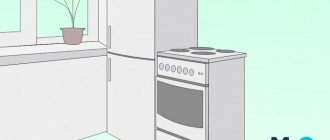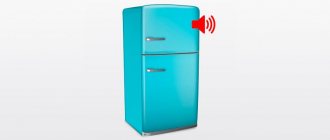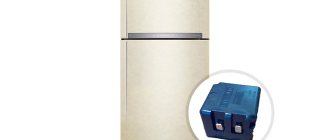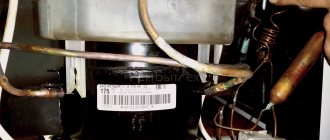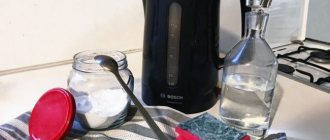The refrigerator is an important kitchen appliance that maintains the freshness and quality of food. If your unit is collecting water under the bottom trays or on the floor, you can assume that the drainage in the refrigerator is not working.
A minor nuisance can become a factor in serious damage and failure of the engine. To eliminate the cause of the leak, clean the drainage installation.
Interior of moisture removal system
How it works
Modern installations require rare defrosting - 1-2 times a year. Nofrost technology allows you to defrost the unit once every two years. This operation is possible thanks to the drainage-evaporation system.
The condensation scheme of the freezer is a model where drops of water are collected by settling moisture on the back wall and flowing to the drainage tube.
The operating principle of the condensate removal system is as follows:
- When the compressor is active, the refrigeration chamber is cooled;
- The temperature in the food storage chamber decreases, the resulting steam condenses on the rear panel;
- Condensation flows down the wall and collects in a gutter;
- Through the tube in the refrigerator, moisture is discharged into the tray;
- The condensate gradually drops into the engine, which ensures the operation of the compressor;
- The compressor operating temperature is above room temperature, moisture evaporates into the external environment and does not require special collection.
Reservoir for collecting moisture
If the equipment is working properly, then the operation of the installation does not require intervention. In case of clogging and malfunction, leaks occur and the risk of engine failure occurs.
Important! The accumulation of liquid under the installation should not be ignored; this is a symptom of a serious breakdown.
How to clean the drainage hole if the blockage occurs at the outlet of the chamber. The liquid does not flow down the tube, but accumulates at the drain level. Ice forms on the back wall of the chamber, which increases the load on the compressor and shortens its service life. The temperature in the freezer may rise, which will lead to food spoilage and the possibility of poisoning.
nofrost technology is based on the same principles as installations with a drip collection system. Except that the drainage and evaporation system is located behind the rear wall, its parts are hidden from the consumer. To gain access to installation and maintenance, the rear panel of the device must be removed.
Common signs that your drain needs to be cleaned
The following signs are true for air conditioners of any type:
- when the refrigerant rate decreases, the evaporator temperature in the system decreases, as a result of which an ice crust forms on it. In this case, the path for removing condensate from the system to the drain pan will be blocked, and the accumulated moisture will simply drip onto the floor in the room. The system also reacts to heavy accumulation of dirt and dust in the filter elements and on the evaporator;
- If the split system is not equipped with an automatic pressure control sensor, then when the outside air temperature drops, the pressure in the cooling system may decrease, which will affect the evaporator temperature - it will also decrease, even with a normal coolant level. The effects of lowering the evaporator temperature are described in the previous example;
- When the device is operating in cooling mode in winter, the water in the drainage tube may simply freeze. Negative temperatures outside lead to freezing of condensate inside the tube through which it should escape outside. In this case, it is necessary to clean the drainage of the split system by first disassembling the drainage elements to warm them up and remove accumulated debris and ice residues.
Signs of the need to clean the system in air conditioners with condensate drainage by gravity
In such devices, moisture accumulated on the evaporator fins drips into the pan, after which it is removed outside through the drain hose. The following causes of blockage are typical for this type of equipment:
- At the time of installation of the equipment, the installers bent the drainage tube in such a way that a water plug was formed in it, preventing unpleasant odors from penetrating through the drainage system into the room. This seemingly good improvement often causes poor water flow through the tube, water and dirt stagnating in the zigzag elbow, and as a result, the device begins to drip into the room;
- Infrequent maintenance of the system leads to the accumulation of dirt and clogging of the fluid drain hole in the pan. The liquid is not removed and begins to drip into the room;
- Often the cause of digging is mechanical damage to the pan or drain hose. Typically, this problem occurs due to poor-quality material used for the drainage pipe, which may crack over time, or poor-quality connection of individual parts of the drainage hose;
- violation of the device assembly technology. In this case, the outlet pipe may be located above the level of the hole in the storage tank and, accordingly, the liquid is not removed, but seeps into the apartment.
Signs that the system needs to be cleaned in equipment with a drain pump
In such systems, condensate is removed from the system using a drain pump. The causes of blockage and the need for equipment maintenance in such systems may be the following:
- the accumulation of dirt in the float chamber leads to interference with the movement of the float or its complete fixation. In this case, the drainage pump stops turning on and condensate removal stops;
- a similar problem occurs when a contactless or float sensor fails;
- failure of the pump itself. Even the presence of a familiar sound does not indicate the complete serviceability of this unit. As a result, the liquid is not removed from the system and begins to leak into the room;
- blocking the tube that removes air when the pump is running leads to its stop;
- oxidation of the contacts on the power terminals of the drainage pump leads to malfunction and complete stop.
What causes drainage to become clogged?
- Several reasons can cause a freezer to break down or become less efficient. The main problem is that food particles get into the drain on the back wall and the tube becomes clogged from the inside. This situation can occur when a liquid spills, crumbs get in, or the integrity of the packaging is compromised. At the entrance to the hole in the tube, deposits of salts and particles of products accumulate, which cannot increase in size due to contact with water and block the outlet hole.
- Another common mistake is overloading the storage room. Because of this, the products are placed close to each other and to the back wall. When the compressor is operating, particles of food and packaging can freeze to the rear wall, and during defrosting, flow into the drain hole into the tank and clog the hole.
- Incorrect installation of the unit. If the refrigerator is skewed in any plane, excess moisture collection is observed. This entails a violation of the tightness due to loose fitting of the doors, deformation of the water receiving tank is observed, and a displacement of the area where moisture enters the compressor. A large amount of condensate forms, which does not have time to evaporate, thickens, and clogs the drain. If the tube is not clogged, the liquid intake tank may overflow, causing water to overflow.
For normal operation of household appliances, it is necessary to keep the unit clean and carry out maintenance. Even with minimal knowledge and the availability of simple tools, it will be possible to avoid clogging and keep the equipment in good condition. The person will only need to be attentive and carefully follow the recommendations.
Preventing system contamination
Cleaning the tube in the refrigerator is an opportunity to extend the life of the device. In order for the drainage to become clogged less often or not to become clogged, it is necessary to follow preventive measures:
- Do not allow condensation to accumulate on the chamber surfaces.
- Make sure the doors are sealed.
- Do not store food without packaging.
- Do not place the refrigerator near heating appliances.
- Do not push food close to the back wall.
- Defrost and wipe the household appliance in a timely manner.
- Keep an eye on the water tray on the compressor.
Simple manipulations will avoid damage, and cleaning the refrigerator drainage will not be required.
Methods for cleaning the drain hole
It is easier and cheaper to prevent breakdowns and malfunctions than to urgently repair them. Depending on the severity of the blockage, there are methods of varying complexity.
- Cleaning the drainage hole using a special plumbing brush. To do this, you need to clean the inlet hole with a napkin, insert the brush into the drain, carefully turn it, and remove it. In case of contamination, rinse with running water and repeat the operation if necessary. If you can’t find a special brush, you can use a cotton swab to clean your ears; you may need several sticks for cleaning; after one use, you can throw away the stick and take the next one, this cleaning will be hygienic.
- Flushing the hole with a stream of water. How to clean a refrigerator drain if there is a slight blockage? To create pressure using water, a syringe or bulb is suitable. Flushing begins after the unit has defrosted. You need to draw warm water with a syringe or bulb; you can add an antiseptic to the solution. Contaminants may have accumulated in the tube, causing bacteria to multiply and create an unpleasant odor. A stream of water must be directed forcefully into the drain hole, and if necessary, rinse the tube again. When flowing out, the liquid from the compressor side must be clean and transparent.
- Cleaning the tube using a cable. If the previous methods did not help and the hole turned out to be clogged with solid particles, then cleaning it with an elastic wire or cable will help. When performing the operation you need to be as careful as possible. The sharp end can be wrapped with electrical tape, in which case there is less chance of damaging the tube. Otherwise, it will not be possible to remove condensate from the chamber, and leaks will be constant. Cleaning the refrigerator drainage system is possible from the top and bottom. After removing dirt, the tube should be rinsed with a disinfectant solution and then with warm water. In some freezer models, the tube can be removed and washed more efficiently.
Water in the refrigerator: reasons for its appearance
A common reason why water accumulates under plastic vegetable drawers in the refrigerator is a clogged drain hole or drain tube located on the back wall of the refrigerator.
Drip defrost refrigerator diagram.
A blockage can form due to crumbs, food debris and dust getting into the drain, washed off from the back wall by drops of water when the tube thaws or freezes. After some time, you will be able to see how the refrigerator is leaking. If the blockage is not removed in time, an unpleasant odor will appear in the chamber, and the evaporator will begin to become covered with ice.
To get rid of the smell and restore normal operation, you must immediately clean the drain hole and hose as soon as water appears. Depending on the cause of the blockage, two cleaning methods are used.
If your refrigerator continues to freeze, then there is no need to panic - the problem has not affected the important components of the unit, which means everything can be fixed. It is much worse when a puddle on the floor is accompanied by the fact that the refrigerator does not work at all.
We suggest you familiarize yourself with How to cancel a program in a Redmond multicooker
If everything is working and all you are worried about is the water, then you should take a closer look at your refrigerator and find out exactly where and how the water is being discharged from the refrigerator.
How to clean drainage in NoFrost refrigerators
In no frost models, the drainage system is hidden behind the back of the panel directly on the refrigerator body. For installation maintenance, it is better to contact a specialized service. Self-cleaning is only possible with good skills in working with household appliances or after observing the work of a professional.
How to clean the refrigerator drain hole when ice forms on the bottom of the freezer. When excess ice occurs, it is worth thinking about the functionality of the moisture removal system. The load on the compressor can cause the temperature in the refrigerator compartment to rise, despite the set mode.
The drainage system may be disrupted by freezing of liquid collection areas. Before calling a technician, you need to defrost the refrigerator, unplug it and keep it at room temperature for 2 days. If the problems persist after turning on the device, it is better to seek help from a service center for repair and maintenance of equipment.
How to clean the air conditioner drain
Often the owner himself tries to clean the drain pipe of the air conditioner at home using improvised means, for example, wire. This method allows you to solve the problem, but only for a few days. Soon, debris from the heat exchanger will re-enter the drainage system and clog the drain hose, causing the air conditioner to leak. Therefore, it would be correct to clean not only the drainage system, but also to sanitize the filters located in the indoor unit.
Before you clean the air conditioner drain yourself, you should study the operating instructions for the installed wall-mounted unit, but in most cases the device must be partially disassembled. It’s better to watch the video on how to properly dismantle it.
The system is cleaned in the following sequence:
Preliminary preparation. Before cleaning the drainage of the air conditioner, you should disconnect the device from the electrical network. Then you need to remove the cover that blocks access to the indoor unit of the air conditioner.
Cleaning filters. After removing the cover, the coarse filters can be removed. They should be washed under running water, using, if necessary, a soap solution to remove old dirt. Washed filters must be dried thoroughly.
Cleaning the tray. The next step is to remove the pan in which the condensate accumulates, while simultaneously disconnecting the drain hose. In order for the operation to proceed correctly, it is recommended to clarify the disconnection method in the operating instructions. The pan is thoroughly washed with soapy water; it is especially important to thoroughly clean the drain hole.
Cleaning the drain pipe. To clean the drain pipe, use a vacuum cleaner. With regular cleaning, it does an excellent job of removing dirt, but if the system was last serviced a long time ago, you will have to pour a special liquid for cleaning air conditioners inside the tube, which will soften the blockage. The liquid is poured into the tube using a syringe and waited for about 30 minutes, after which the vacuum cleaner is used again to remove the softened dirt.
Disinfection of the system. After completing all system cleaning procedures, care should be taken to disinfect the device. To treat the tray, filters and tube, you can use chlorhexidine at home, which can be purchased at any pharmacy (a review of the products is given in this article, and the general procedure for cleaning split systems can be found here).
The tray is wiped with a cloth soaked in the solution, the filters are treated with a spray bottle, and chlorhexidine is simply poured into the drain tube for 15 minutes, after which it is washed with running water.
The final stage. After processing the main systems, use a soft clothes brush to remove dust and dirt from the heat exchanger and replace the cover.
Regular air conditioning maintenance will help maintain a favorable and safe climate in the apartment.
Use of disinfectants
To disinfect the drain tube, the use of antiseptics is required, since the food storage chamber is directly connected to the condensate collection system. Mold, fungi, and bacteria can accumulate in the tube. After cleaning, it is possible to close the drainage hole in the refrigerator in front of the condenser. The disinfectant solution can be left for 5-7 minutes.
After settling, the tube is washed several times to remove the disinfectant. There are various types of disinfectants based on chlorine and hydrogen peroxide. Depending on the activity of the disinfectant, the exposure time may vary; before use, you should read the instructions.
Dehumidification system for nofrost devices
The use of special chemicals to kill bacteria
When cleaning the drain hole of the unit, it is important to use a solution of soap and soda, which can be collected in a syringe and then pressed along the entire hose. It is also important to use disinfectants. Such preparations may contain chlorine, but their disadvantage is their strong aroma. After a certain time, the product is drained, and the system itself is washed with lukewarm water. It is also fashionable to use hydrogen peroxide 3%.
In addition to aggressive cleaning chemicals, peroxide will perfectly remove microorganisms from various surfaces, including refrigerator elements made of plastic.
If you don't clean the drain
Important! For high-quality operation of the equipment, maintenance of the drainage system should be carried out every six months. Even if all recommendations are followed, the risk of blockage is high. If you ignore the recommendation, problems may appear after a while.
- Unpleasant odor, even after wet cleaning. Fragrances, odor absorbers, and disinfectants do not help solve the problem.
- Spoilage of products before the stated date, subject to temperature conditions. Perishable foods may become moldy and sticky.
- Penetration of moisture under the body, destruction of metal elements that are prone to corrosion. Unnoticed leakage of water droplets can cause deformation and damage to equipment components.
- Possible short circuit. If moisture gets on contacts that are under voltage, it can cause a short circuit, failure of equipment, and loss of power to the entire house.



